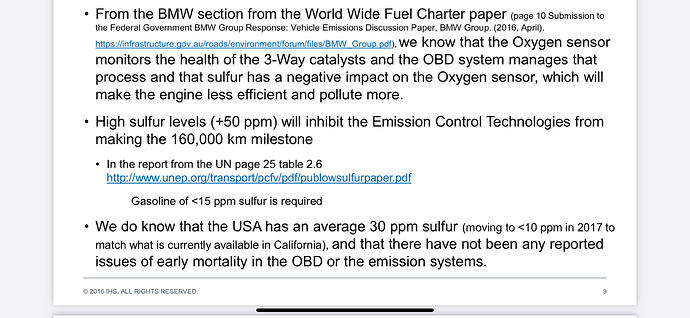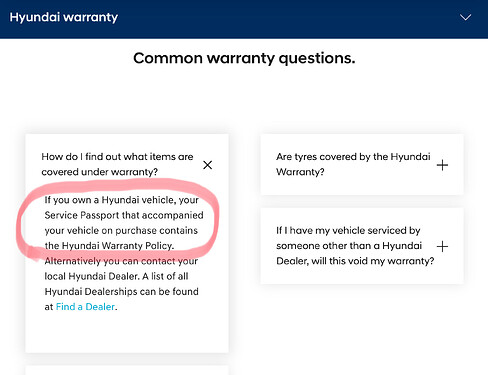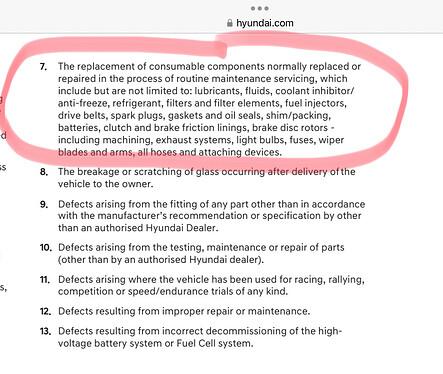I have a 2022 Santa Fe with only 45,000 kms on the clock. The check engine light has been on continuously for the last week.
I have been told that it probably is a faulty oxygen sensor or catalytic converter.
Conveniently the Hyundai warranty excludes them ( I wonder why )
So my question is IS THIS A COMMON PROBLEM ?
Welcome to the community @Sceatsie
Your question is getting a little technical.
Does Hyundai list both as consumable components?
There is an Australian Hyundai Owners Club listed on Facebook. Another place to reach out.
45,000 km sounds unusually low for the lifetime of a cat converter. That there are two component failures suggests there may be another issue that has caused the failures. Another option is to search for a local independent mechanical service that promotes itself as a Hyundai specialist for their assessment and advice.
As our fuel standards are so poor (both for diesel and gasoline), it could be argued that components subjected to higher than expected contaminants have lesser coverage. On the warranty documentation this may be the explanation as to why than otherwise might be expected elsewhere in the World that have higher standards.
High sulphur fuels have adverse outcomes on both the oxygen sensors and the catalytic converter among other emissions control tech.
and from Australian Petrol Fuel Quality — Vehicle maintenance news.
“
Sulphur
Why is there such a big focus on sulphur content in fuel, both in quality and regulation? As a natural component of crude oil, sulphur content has been a key topic especially as it relates to emissions. A byproduct of combusting fuel that is laden with high sulphur content is sulphur oxides and secondary particulate sulphates. These types of emissions are harmful to health, the environment, and the vehicle emission systems themselves. As the need for higher efficiency emission systems advances, protecting their integrity and functionality does as well.
“Excess sulphur byproducts poison emission systems over time.”
Fuels with low sulphur content provide low sulphonated byproduct amounts. This results in a lower potential to poison catalytic converters, selective catalytic reducers, and particulate filters. Over time, the emissions systems designed to keep unburnt fuel, oxides of nitrogen, and particulate matter out of the air can’t do their job efficiently. A more immediate effect that acidic sulphonated byproducts have on vehicles is the premature breakdown of engine oil. High service intervals combined with modern engine oil specifications yield problems when they encounter excessive sulphur-containing fuel. Even the latest highest-performing engine oil specifications on the market are susceptible to premature breakdown https://www.researchgate.net/publication/284976002_Sulfur_poisoning_mechanism_of_three_way_catalytic_converter_and_its_grey_relational_analysis(oil sludge) from poor quality Australian fuel. Engine oil sludge is the severe form of an engine oil breakdown, here you can read about engine oil sludge removal. The removal of sulphur in all types and grades of fuel has become a new key requirement for meeting the latest environmental and technological needs of the world.“
Further optional reading
First I’ve ever heard that an oxygen sensor, or catalytic converter, are items to be replaced in servicing.
But, if the engine check light is on, then there would be an error code logged in the OBD system pointing more specifically to the issue. O2 sensor likely.
Some general observations on Hyundai new vehicle warranties and catalytic converters.
New vehicle owners may find a more detailed answer in the documentation supplied with the vehicle at time of purchase. Online Hyundai offer the following in respect of exclusions:
Note the list provided refers to “ replacement of consumable components normally replaced or repaired in the process of routine maintenance” as excluded items. The “but are not limited to” leaves it open for debate about other items not listed.
One would need to refer to the Service Passport provided for a specific vehicle to note any references to the O2 sensors and catalytic convertor. Some service booklets list items as an inspect/test and replace if required. Although if expensive components such as O2 sensors and CC’s might need replacing one could ask why they are not included in the exclusions list. Alternately to ask if there is a specific reference such as for tyres and batteries.
Anecdotally catalytic converters are supposed to last a long time for a properly maintained vehicle with normal conditions of use.
There are numerous references online to possible causes of early catalytic convertor failure. Refer to prior post per @grahroll. Note failure of an O2 sensor may subsequently lead to failure of a CC. The performance of a faulty O2 sensor may alternately indicate incorrectly the CC has failed. One is very much exposed to the OEM and reliability of the service providers staff. There is always a possibility of an underlying defect with the vehicle engine leading to the failures.
To consider there are other nations which enforce more stringent requirements on the performance of vehicle exhaust emissions. These may include regular testing and or warranted performance by years and milage. EG Frequent Questions related to Transportation, Air Pollution, and Climate Change | US EPA.
Unfortunately, the ‘exhaust’ system seems to be excluded in the warranty. So that would include the O2 sensor and CC along with muffler and pipes. Not covered.
Is it a common problem? Not in my experience with cars I have owned. May have had a muffler replaced after a stone put a hole in it, but never the CC or O2 sensor. They should just sit there quietly doing their job for many years
A little off topic, but since when have fuel injectors been classed as consumables?
Yes I suspect that there may be another issue Thank you so much for the help
I will have some interesting research
Diesel
Cheers.
With many modern diesel engines, they have a diesel particulate filters (DFP) which can easily build up with particles if the engine isn’t run hot and long enough for the build-ups to be burnt off. Hot enough and long enough usually means regular stints of highway driving, where the engine runs at higher revs causing it to run hot (along with its exhaust). The issue is unrelated to fuel quality or a manufacturing defect.
The DFP is a device on the exhaust system which is installed to reduce particulates from burning diesel. These particulates are known to cause respiratory issues and is mandated for installation on light vehicles.
It is a common problem for modern diesel vehicles which are used mainly around town to have DFP issues, irrespective of the make or models. This is because through everyday city driving engine exhaust doesn’t get hot enough for a long enough period to clean out the DFP.
If there is particulate build up in the DFP, it is also likely to start building up elsewhere in the exhaust system, including over an oxygen sensor (or in the diesel oxidation catalyst, selective catalyst reduction system and/or exhaust gas recirculation system). Hence why the mechanic has indicated that it could be either devices (or both).
Build up within the DFP is usually excluded from warranties as it is due to the use of the vehicle and not a manufacturing defect. I say usually as there has been design/manufacturing issues with some.
Nor here, although we recently replaced an O2 sensor on the Toyota at around 215,000km.
Agree with the unfortunately. It’s a very expensive exclusion depending on the definition accepted, starting at or from the exhaust manifold/s. Times two for some ICE including certain V6 and V8 models with split exhaust systems.
Whether the manufacturers exclusion of either component would stand a challenge through Fair Trading or with respect to the ACL - the components of the exhaust system would still need to meet consumer statutory guarantees. The opening position to ask what constitutes a reasonable or acceptable life for a catalytic convertor under normal operating conditions. It would require a more detailed discussion. Difficult without greater expert knowledge and of the reported failure to suggest an outcome. To note the OP’s request looking for others with similar early failures in search of an explanation.
A notable exception, if the failure has arisen due to a manufacturing defect or as a consequence of an engine fault that is warrantable - one response likely in favour of the owner. Providing supporting evidence a challenge, excepting where the Manufacturer or service agent has advised that assessment.
The ECU logs should provide a record of when the O2 sensor was noted as faulty. To look for other signs of engine performance issues that might have caused the CC to fail requires a detailed diagnostic report and expert evaluation. The OP may not be inclined to go down that path with a third party. There are costs in doing so vs accepting the Hyundai service advice. Taking the second option there is wisdom for the OP to insist on a detailed written assessment from Hyundai as to the cause of the early failure. One does not want to be back to them in another 2 years or 45,000km or sooner with a repeat of the same failure.
Well now that the engine is revealed as a diesel, it becomes more complicated in the exhaust system. The catalytic convertors are not the same as it petrol cars. There is AdBlue fluid to be considered. There is the particulate filter.


